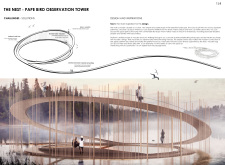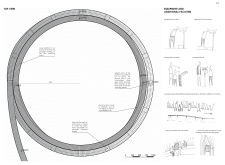5 key facts about this project
### Project Overview
The Pape Bird Observation Tower, named "The Nest," is situated within a delicate ecological setting, designed to enhance birdwatching while promoting a meaningful connection between individuals and their natural surroundings. Inspired by the structure of a bird's nest, the design reflects themes of observation, leisure, and education.
### Spatial Strategy and User Accessibility
The tower features two circular pathways at distinct elevations—one at water level and another elevated to 6.5 meters. This configuration promotes universal accessibility, accommodating diverse user groups, including families and individuals with mobility challenges. The integration of gentle ramps connecting the two levels facilitates easy navigation, while strategically placed wooden benches encourage visitors to engage with the environment. The layout and design prioritize minimal disruption to local wildlife, ensuring that visitor experiences are both immersive and ecologically considerate.
### Material Selection and Environmental Integration
Construction materials were chosen for their natural aesthetic and compatibility with the surroundings. Treated wood serves as the primary structural material, while metal strings act as unobtrusive barriers to enhance visibility for birdwatchers. Driven piles provide structural stability in the marshy terrain, and wooden cylindrical panels, varying in diameter, obscure human presence, thereby reducing disturbances to birdlife. This careful selection of materials underscores a commitment to ecological integrity, reinforcing the tower's role as both a viewing platform and a space for preservation and education.






















































